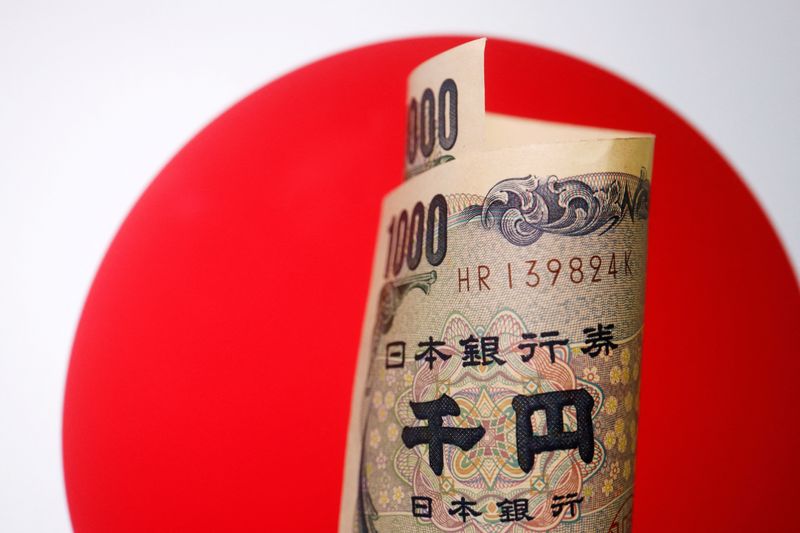Forex
Yen nervy as markets on intervention alert; Aussie slips after RBA


© Reuters. FILE PHOTO: A banknote of Japanese yen is seen in this illustration picture taken June 15, 2022. REUTERS/Florence Lo/Illustration/File Photo
By Ankur Banerjee
SINGAPORE (Reuters) – The yen was firm on Tuesday but remained vulnerable to more weakness, as markets were on alert for signs of intervention, while the Australian dollar dropped after the country’s central bank chose to stand pat on interest rates.
The Reserve Bank of Australia (RBA) held interest rates steady at 4.10%, saying it wanted more time to assess the impact of past hikes, but warned further tightening might be needed to bring inflation to heel.
Across the currency markets, investors remained on watch for possible intervention by Japanese authorities to stem yen losses.
The last fetched 144.64 per dollar in Asian hours, but remained close to last week’s eight month low of 145.07 per dollar that prompted Finance Minister Shunichi Suzuki to warn against excessive yen selling.
Earlier on Tuesday, Japan’s top financial diplomat Masato Kanda said that officials were in close contact with U.S. Treasury Secretary Janet Yellen and other overseas authorities almost everyday on currencies and broader financial markets.
“This is sending signals that a coordinated intervention may be coming as yen continues to hover above 144 per dollar,” said Charu Chanana, market strategist at Saxo Markets.
“A coordinated intervention usually has a longer lasting impact on the yen than a unilateral intervention would have.”
Japan bought yen in September, its first foray in the market to boost its currency since 1998, as the Bank of Japan’s pledge to retain ultra-loose policy as long as required drove the yen as low as 145 per dollar. It intervened again in October after the yen plunged to a 32-year low of 151.94.
The slid 0.3% to $0.6654 after the RBA’s decision, reversing its early morning gains.
“The RBA’s steady hand is probably only a flesh wound for the , having been about 60% priced in and with no great rhetorical shifts in the statement,” said Sean Callow, a senior currency strategist at Westpac.
Markets had leant toward a steady outcome given inflation had eased a little more than expected in May, while economists were split on the outcome, with 16 out of 31 polled by Reuters expecting a hike and the rest forecasting the bank to stand pat.
Since a surprise pause in April and subsequent hikes in May and June, economists have been mostly divided in recent months over the RBA’s next move.
Against a basket of currencies, the dollar rose 0.097% at 103.05 after data overnight showed U.S. manufacturing slumped further in June, reaching levels last seen when the nation was reeling from the initial wave of the COVID-19 pandemic.
“We expect the U.S. economy to face a recession starting in Q3 23,” Kristina Clifton, senior currency strategist at Commonwealth Bank of Australia (OTC:), adding that it was likely to be a quiet day for the currency market with no major data releases or central bank speech scheduled. U.S. markets are closed for the July 4 Independence Day holiday.
Investor focus this week will be on nonfarm payrolls data along with jobs report for more clues about the broader labour market in the United States. Minutes of the U.S. Federal Reserve’s June meeting are also due to be released on Wednesday.
Markets are pricing in a near 87% chance of a 25 basis point hike in the next Federal Reserve meeting at the end of the month, the CME FedWatch tool showed.
The euro was down 0.13% to $1.0897, while sterling was last at $1.2685, down 0.05% on the day. The New Zealand dollar eased 0.15% to $0.614.

 Forex3 years ago
Forex3 years agoForex Today: the dollar is gaining strength amid gloomy sentiment at the start of the Fed’s week

 Forex3 years ago
Forex3 years agoUnbiased review of Pocket Option broker

 Forex3 years ago
Forex3 years agoDollar to pound sterling exchange rate today: Pound plummeted to its lowest since 1985

 Forex3 years ago
Forex3 years agoHow is the Australian dollar doing today?

 Cryptocurrency3 years ago
Cryptocurrency3 years agoWhat happened in the crypto market – current events today

 World3 years ago
World3 years agoWhy are modern video games an art form?

 Commodities3 years ago
Commodities3 years agoCopper continues to fall in price on expectations of lower demand in China

 Economy3 years ago
Economy3 years agoCrude oil tankers double in price due to EU anti-Russian sanctions





















